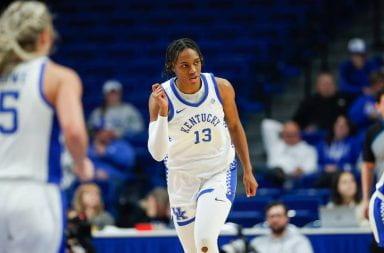Last July, Nataya Kimble and about forty others waited in the Top Hat Restaurant in Junction City, Ohio, a small town in Perry County, to welcome the president of the university she would attend that fall.
Later that day, Kimble would have the chance to meet President E. Gordon Gee, who was passing through on his annual summer tour of Ohio.
Kimble, a second-year in biology from New Lexington, Ohio, a town about six miles outside of Junction City, said she heard about the event from a friend and liked the idea of meeting Gee one-on-one.
“I think it’s a really good idea because it’s important for the future freshman students to see who the president is and get to know him personally,” Kimble said.
From her short interaction with Gee, Kimble said he made a positive first impression.
“He’s so great. He’s such a gentleman, and he’s very nice. He makes you feel like family,” Kimble said.
Gee has been going on the tours since 2008, when he visited all 88 counties in Ohio. Every summer since, he has visited at least 44 counties. This summer, Gee will take his tour bus to Ohio’s southern, northern and northeastern counties, spending two days in each region in a tour that is spread out throughout the summer.
Kellie Uhrig, director of marketing communications in the Office of Student Life, said Student Life interns help decide where Gee visits by compiling lists of events, and Gee and his staff in Bricker Hall make the final call of places that make it on the tours. Students and alumni then work out the details for organizing each visit.
Uhrig said there’s no criteria for a place Gee might be interested in visiting and that he is open to any suggestions.
“He never limits the way he chooses places,” Uhrig said. “What’s interesting in Ohio is where he wants to visit.”
No visit is exactly alike, Uhrig said, but all visits are high-energy and resemble a pep rally, complete with music, cheerleaders and Brutus Buckeye.
“It’s all about that Buckeye atmosphere,” Uhrig said.
Michael Thomas, a third-year in architecture, met Gee at Tom’s Ice Cream Bowl in Zanesville, Ohio, last July as part of Gee’s summer tour. Thomas said he sees the summer tours as another way to lure students across the state to attend Ohio State.
“I think it’s a political stunt,” Thomas said. “He (Gee) was there for the students, but at the same time I feel like it’s just another recruiting technique.”
While the budget of Gee’s summer tours was not immediately available, Gee’s travel expenses have recently been under scrutiny. The Dayton Daily News reported that Gee has racked up $550,000 in travel costs in the past two years. Gee’s travel expenses come out of endowment funds rather than out of tuition or tax money, according to the report.
Thomas said he thought the portion of Gee’s travel budget that is spent on the summer tours is money well spent.
“I feel like it’s money that’s easily recouped by the university,” Thomas said. “I mean if it is a recruiting move, then they’re going to make that back.”
Last summer Gee made 75 stops in 47 counties over the course of 10 days, logging 2,799 miles. Among his stops, Gee saw the world’s largest pan at the American Pan Factory in Urbana, made his first batch of apple dumplings at the KitchenAid plant in Greenville and visited the Spangler Candy Company in Bryan that produces 10 million Dum Dum suckers each day in its factory.
Stops on this year’s tour will include a visit to the Fayette County Fair, the Feed the World livestock export facility in Sabina, the Silver Bridge Coffee Company in Gallipolis and the Snowville Creamery dairy farm in Pomeroy.
Gee said in a statement that he cherishes his time spent on the tours because it allows him to see the impact OSU has on the state of Ohio.
“The relationship between Ohioans and the university is one of enormous value and importance. These tours let me get out and meet new people from around the state, all united by one thing — a boundless enthusiasm for The Ohio State University,” Gee said.
Kimble said Gee’s summer tours help separate Gee from other college presidents who aren’t as active in the on- and off- campus communities.
“Some people go their four years of college not meeting their president,” Kimble said.


